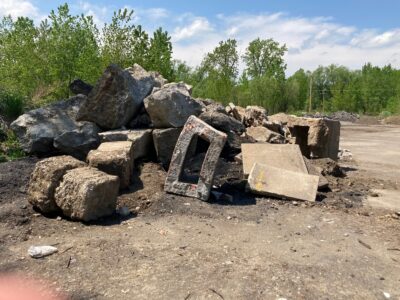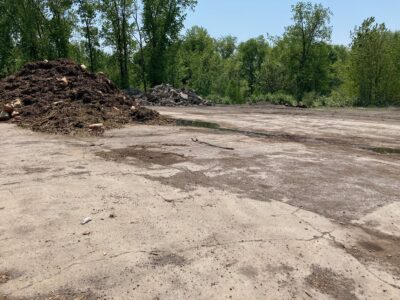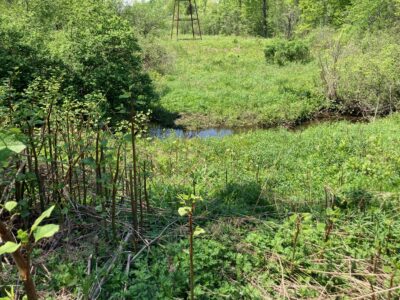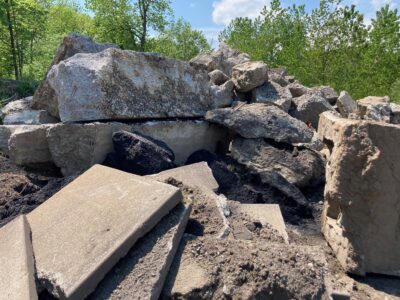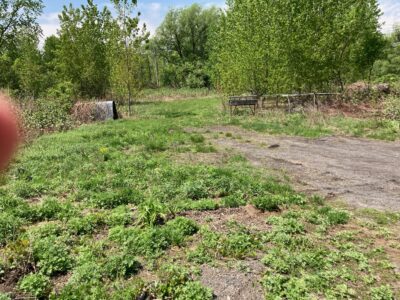50+ years have passed since I and my gang visited The Flume, a water filed Nirvana and fishing spot that we all relished. I still vaguely remembered the approximate location of the entrance, so today, I decided that I would relive the glories of my youth. After a lunch with my brother and my son, I decided to head over to the entrance and find the path in. I might even try dancing across one of the beams and do a hootchie kootchie dance mid beam, were I to feel spry enough. Well I found the entrance at the end of a dead end street called Grove, but what greeted me was a post apocalyptic scene of monstrous proportions. The entrance was a strewn pile of rubble and giant concrete blocks, overgrown underbrush, and stinky old piles of rotting wood. I could vaguely detect a bubbling stream off through the trees and even had a glimpse of a creek. I dared not wade through the impenetrable underbrush for fear of ticks and getting lost, perhaps never to return. I can only assume that the giant piles of rubble are what is left of the Flume after its destruction at the hands of whoever put the giant cement blocked leather mill there. So there you go, one more piece of my youth lost and deposited on the ash heap of history. I recount below the glory days of the Flume for whoever is left of humanity after the next Zombie Apocalypse.
The Flume was a set of ancient ruins located at the end of a path through a maze of tangled underbrush and trees. The path started at the end of a dead end street on the “east side of town”. I doubt that I could even find the place today, since my memory of the exact location is quite dim. In fact I am reminded of The Chronicles of Narnia, in which Lucy and the gang can never recall exactly how they got to Narnia by climbing through an old wardrobe. In any event, I shall try to recount the wonder that was the Flume.
The ruins consisted of a massive concrete and stone structure that looked like a giant cage. The top of the cage was a set of stone beams that were about 20 feet across and two feet wide. 15 feet below the beams was the bottom of the cage. It was filled with water that flowed from a creek over a concrete dam and into a large pool. In the large pool was the biggest damn carp that you ever saw.
The greatest challenge with getting to the Flume was that you had to walk through another neighborhood. That was always a dangerous adventure, as you didn’t know if the tribes in the other neighborhood were friendly, hostile, or downright demonic. In this particular case, it was somewhere between friendly and demonic. The guardians of the street were the Klingbiels and the Hornings. The two kids that I remember the most clearly were Jeff Klingbiel and Terry Horning. These boys were both a bit bipolar in that on any given occasion, you did not know if you were going to get chased down the street with a baseball bat or handed a cookie. Terry also had an older brother named Greg, who was reasonably friendly. He did not feel the need to kick the shit out of little kids, which made him A Number One in my book. Later in life Greg would become the police chief of my home town. Who knew?
On any given summer day, there were numerous kids hanging out at The Flume. There was always an adventure to be had, whether it was walking across the beams, making spears, catching frogs, or fishing. Walking the beams was particularly deadly, as one missed step and you were carp food. I had walked the beams a couple of times, and had seen many a kid skitter across the beams, sometimes getting extra style points for doing the hootchie kootchie dance at mid-beam. Never did I see anyone fall, a testament to the superior balance abilities of the kids from my era.
The greatest prize of all was to catch the giant carp. We would sit for hours on top of the concrete cage, staring into the waters in search of the fish. Every so often you would catch a glimpse of it surfacing, but no one ever caught it. You’d think with all of those lines in the water, that someone would at least get a nibble or something. Our bait of choice was bread. We had concluded that this was the best bait after doing a market survey with the minnows along the shore line. The bread had to be rolled into tight little balls so that it would stay on your hook whilst submerged. Since we never caught the fish, I must conclude that he/she was either on a gluten free diet or had Celiacs disease.
Why was it called “The Flume”? I don’t even remember who told me that it was called that, but somehow, if you said the words, everybody knew exactly what you meant. I looked it up in the dictionary and the closest thing I could find was “An artificial channel conveying water, typically used for transporting logs or timber”. There was definitely water there, but no logs or timber. I am sure at some future date, archeologists will unearth the Flume and sample the soil to discover what it might have been used for. They will probably conclude that it was used for baking bread. Makes ya wonder about other scientific discoveries don’t it?

